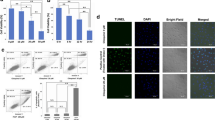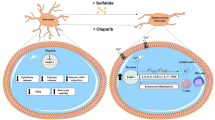Abstract
Central nervous system (CNS) infections due to Pseudomonas aeruginosa are difficult to treat and have a high mortality rate. Pyocyanin, a virulence factor produced by P. aeruginosa, has been shown to be responsible for the majority of P. aeruginosa’s pathogenicity in mammalian cells. Several lines of evidence in respiratory cells suggest that this damage is primarily mediated by pyocyanin’s ability to generate ROS and deplete host antioxidant defense mechanisms. However, it has yet to be established whether pyocyanin or 1-hydroxyphenazine have potential toxicity to the CNS. Therefore, the aim of this study was to compare the CNS toxicity of pyocyanin and 1-hydroxyphenazine in vitro and to provide insight into mechanisms that underlie this toxicity using 1321N1 astrocytoma cells. To achieve this, we investigated the contribution of oxidative stress and other mediators of cell death including autophagy, senescence and apoptosis. We show that oxidative stress is not a primary mediator of pyocyanin (0–100 μM) and 1-hydroxyphenazine (0–100 μM) induced toxicity in 1321N1 cells. Instead, our results suggest that autophagy may play a central role. The autophagy inhibitor 3-methyladenine (5 mM) protected 1321N1 astrocytoma cells against both pyocyanin and 1-hydroxyphenazine-induced cell injury and increased accumulation of acidic vesicular organelles, a hallmark of autophagy. Furthermore, apoptosis and senescence events may be secondary to autophagy in pyocyanin and 1-hydroxyphenazine-mediated cell injury. In conclusion, this study provides the first evidence on mechanisms underlying the toxicity of both pyocyanin and 1-hydroxyphenazine to astrocytoma cells and provides novel evidence suggesting that this toxicity may be mediated by the formation of acidic vesicular organelles, a hallmark of autophagic cell death.






Similar content being viewed by others
References
Amitani R, Wilson R, Rutman A, Read R, Ward C, Burnett D, Stockley RA, Cole PJ (1991) Effects of human neutrophil elastase and Pseudomonas aeruginosa proteinases on human respiratory epithelium. Am J Respir Cell Mol Biol 4(1):26–32
Anoopkumar-Dukie S, Carey JB, Conere T, O’Sullivan E, van Pelt FN, Allshire A (2005a) Resazurin assay of radiation response in cultured cells. Br J Radiol 78(934):945–947
Anoopkumar-Dukie S, Conere T, Carey JB, Allshire A (2005b) Radical mediators and mitogen-activated protein kinase signaling in oxygen-dependent radiosensitivity of human tumor cell lines. Free Radic Biol Med 39(2):188–194
Anoopkumar-Dukie S, McMahon A, Allshire A, Conere TJ (2005c) Further evidence for biological effects resulting from ionizing radiation doses in the diagnostic X-ray range. Br J Radiol 78(928):335–337
Anoopkumar-Dukie S, Conere T, Sisk GD, Allshire A (2009) Mitochondrial modulation of oxygen-dependent radiosensitivity in some human tumour cell lines. Br J Radiol 82(982):847–854
Bardeesy N, Sharpless NE (2006) RAS unplugged: negative feedback and oncogene-induced senescence. Cancer Cell 10(6):451–453
Denning GM, Wollenweber LA, Railsback MA, Cox CD, Stoll LL, Britigan BE (1998) Pseudomonas pyocyanin increases interleukin-8 expression by human airway epithelial cells. Infect Immun 66(12):5777–5784
Forteza R, Lauredo IT, Burch R, Abraham WM (1994) Extracellular metabolites of Pseudomonas aeruginosa produce bronchoconstriction by different mechanisms. Am J Respir Crit Care Med 149(3 Pt 1):687–693
Gardner PR (1996) Superoxide production by the mycobacterial and pseudomonad quinoid pigments phthiocol and pyocyanine in human lung cells. Arch Biochem Biophys 333(1):267–274
Gloyne LS, Grant GD, Perkins AV, Powell KL, McDermott CM, Johnson PV, Anderson GJ, Kiefel M, Anoopkumar-Dukie S (2011) Pyocyanin-induced toxicity in A549 respiratory cells is causally linked to oxidative stress. Toxicol In Vitro 25(7):1353–1358
Gopal V, Burke C (1990) Pseudomonas aeruginosa meningitis treated with ceftazidime. Mil Med 155(6):264–265
Huang CR, Lu CH, Chuang YC, Tsai NW, Chang CC, Chen SF, Wang HC, Chien CC, Chang WN (2007) Adult Pseudomonas aeruginosa meningitis: high incidence of underlying medical and/or postneurosurgical conditions and high mortality rate. Jpn J Infect Dis 60(6):397–399
Jackowski JT, Szepfalusi Z, Wanner DA, Seybold Z, Sielczak MW, Lauredo IT, Adams T, Abraham WM, Wanner A (1991) Effects of P. aeruginosa-derived bacterial products on tracheal ciliary function: role of O2 radicals. Am J Physiol 260(2 Pt 1):L61–L67
Kanzawa T, Kondo Y, Ito H, Kondo S, Germano I (2003) Induction of autophagic cell death in malignant glioma cells by arsenic trioxide. Cancer Res 63(9):2103–2108
Kipnis E, Sawa T, Wiener-Kronish J (2006) Targeting mechanisms of Pseudomonas aeruginosa pathogenesis. Med Mal Infect 36(2):78–91
Kurz T, Terman A, Brunk UT (2007) Autophagy, ageing and apoptosis: the role of oxidative stress and lysosomal iron. Arch Biochem Biophys 462(2):220–230
Lau GW, Hassett DJ, Ran H, Kong F (2004a) The role of pyocyanin in Pseudomonas aeruginosa infection. Trends Mol Med 10(12):599–606
Lau GW, Hassett DJ, Ran H, Kong F (2004b) The role of pyocyanin in Pseudomonas aeruginosa infection. Trends Mol Med 10(12):599–606
Lau GW, Ran H, Kong F, Hassett DJ, Mavrodi D (2004c) Pseudomonas aeruginosa pyocyanin is critical for lung infection in mice. Infect Immun 72(7):4275–4278
Lauredo IT, Sabater JR, Ahmed A, Botvinnikova Y, Abraham WM (1998) Mechanism of pyocyanin- and 1-hydroxyphenazine-induced lung neutrophilia in sheep airways. J Appl Physiol 85(6):2298–2304
Lu CH, Chang WN, Chuang YC, Chang HW (1999) Gram-negative bacillary meningitis in adult post-neurosurgical patients. Surg Neurol 52(5):438–443; (discussion 443–434)
Mucke L, Eddleston M (1993) Astrocytes in infectious and immune-mediated diseases of the central nervous system. Faseb J 7(13):1226–1232
Muller M (1995) Scavenging of neutrophil-derived superoxide anion by 1-hydroxyphenazine, a phenazine derivative associated with chronic Pseudomonas aeruginosa infection: relevance to cystic fibrosis. Biochim Biophys Acta 1272(3):185–189
Muller M (2002) Pyocyanin induces oxidative stress in human endothelial cells and modulates the glutathione redox cycle. Free Radic Biol Med 33(11):1527–1533
Muller M (2006) Premature cellular senescence induced by pyocyanin, a redox-active Pseudomonas aeruginosa toxin. Free Radic Biol Med 41(11):1670–1677
Muller M, Sorrell TC (1992) Leukotriene B4 omega-oxidation by human polymorphonuclear leukocytes is inhibited by pyocyanin, a phenazine derivative produced by Pseudomonas aeruginosa. Infect Immun 60(6):2536–2540
Munro NC, Barker A, Rutman A, Taylor G, Watson D, McDonald-Gibson WJ, Towart R, Taylor WA, Wilson R, Cole PJ (1989) Effect of pyocyanin and 1-hydroxyphenazine on in vivo tracheal mucus velocity. J Appl Physiol 67(1):316–323
Nutman J, Berger M, Chase PA, Dearborn DG, Miller KM, Waller RL, Sorensen RU (1987) Studies on the mechanism of T cell inhibition by the Pseudomonas aeruginosa phenazine pigment pyocyanine. J Immunol 138(10):3481–3487
Obritsch MD, Fish DN, MacLaren R, Jung R (2005) Nosocomial infections due to multidrug-resistant Pseudomonas aeruginosa: epidemiology and treatment options. Pharmacotherapy 25(10):1353–1364
O’Malley YQ, Abdalla MY, McCormick ML, Reszka KJ, Denning GM, Britigan BE (2003) Subcellular localization of Pseudomonas pyocyanin cytotoxicity in human lung epithelial cells. Am J Physiol Lung Cell Mol Physiol 284(2):L420–L430
O’Malley YQ, Reszka KJ, Spitz DR, Denning GM, Britigan BE (2004) Pseudomonas aeruginosa pyocyanin directly oxidizes glutathione and decreases its levels in airway epithelial cells. Am J Physiol Lung Cell Mol Physiol 287(1):L94–L103
Rada B, Leto TL (2009) Redox warfare between airway epithelial cells and Pseudomonas: dual oxidase versus pyocyanin. Immunol Res 43(1–3):198–209
Sasaki M, Miyakoshi M, Sato Y, Nakanuma Y (2010) Autophagy mediates the process of cellular senescence characterizing bile duct damages in primary biliary cirrhosis. Laboratory investigation. J Tech Methods Pathol 90(6):835–843
Scherz-Shouval R, Shvets E, Fass E, Shorer H, Gil L, Elazar Z (2007) Reactive oxygen species are essential for autophagy and specifically regulate the activity of Atg4. EMBO J 26(7):1749–1760
Sorensen RU, Fredricks DN, Waller RL (1991) Inhibition of normal and malignant cell proliferation by pyocyanine and 1-hydroxyphenazine. Antibiot Chemother 44:85–93
Stewart-Tull DE, Armstrong AV (1972) The effect of 1-hydroxyphenazine and pyocyanin from Pseudomonas aeruginosa on mammalian cell respiration. J Med Microbiol 5(1):67–73
Tsujimoto Y, Shimizu S (2005) Another way to die: autophagic programmed cell death. Cell Death Differ 12(Suppl 2):1528–1534
Usher LR, Lawson RA, Geary I, Taylor CJ, Bingle CD, Taylor GW, Whyte MK (2002) Induction of neutrophil apoptosis by the Pseudomonas aeruginosa exotoxin pyocyanin: a potential mechanism of persistent infection. J Immunol 168(4):1861–1868
Vicencio JM, Galluzzi L, Tajeddine N, Ortiz C, Criollo A, Tasdemir E, Morselli E, Ben Younes A, Maiuri MC, Lavandero S, Kroemer G (2008) Senescence, apoptosis or autophagy? When a damaged cell must decide its path—a mini-review. Gerontology 54(2):92–99
Wilson R, Sykes DA, Watson D, Rutman A, Taylor GW, Cole PJ (1988) Measurement of Pseudomonas aeruginosa phenazine pigments in sputum and assessment of their contribution to sputum sol toxicity for respiratory epithelium. Infect Immun 56(9):2515–2517
Wu YT, Tan HL, Shui G, Bauvy C, Huang Q, Wenk MR, Ong CN, Codogno P, Shen HM (2010) Dual role of 3-methyladenine in modulation of autophagy via different temporal patterns of inhibition on class I and III phosphoinositide 3-kinase. J Biol Chem 285(14):10850–10861
Young AR, Narita M (2010) Connecting autophagy to senescence in pathophysiology. Curr Opin Cell Biol 22(2):234–240
Acknowledgments
This work was funded by the Griffith Health Institute, Griffith University. The authors would like to acknowledge Dr Milton Kiefel, Ms Katie Powell and Mr Lee Gloyne for technical assistance.
Conflict of interest
The authors have no conflict of interest.
Author information
Authors and Affiliations
Corresponding author
Additional information
Amelia J. McFarland, Shailendra Anoopkumar-Dukie and Gary D. Grant contributed equally to this study.
Rights and permissions
About this article
Cite this article
McFarland, A.J., Anoopkumar-Dukie, S., Perkins, A.V. et al. Inhibition of autophagy by 3-methyladenine protects 1321N1 astrocytoma cells against pyocyanin- and 1-hydroxyphenazine-induced toxicity. Arch Toxicol 86, 275–284 (2012). https://doi.org/10.1007/s00204-011-0755-5
Received:
Accepted:
Published:
Issue Date:
DOI: https://doi.org/10.1007/s00204-011-0755-5




